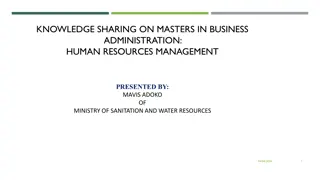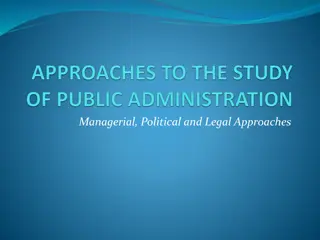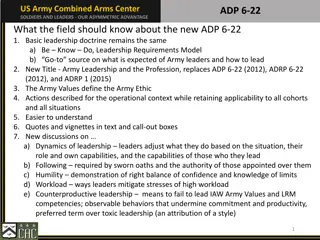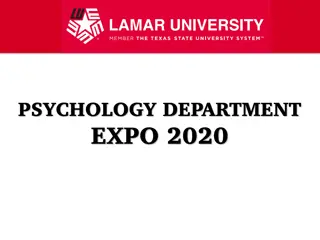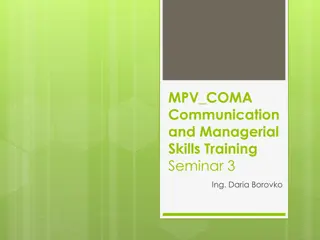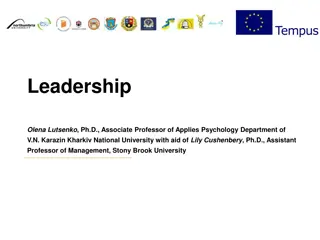Introduction to Leadership Psychology & Managerial Work
This content explores various definitions and perspectives on leadership, emphasizing the importance of understanding effective leadership in influencing others and achieving shared objectives.
Download Presentation

Please find below an Image/Link to download the presentation.
The content on the website is provided AS IS for your information and personal use only. It may not be sold, licensed, or shared on other websites without obtaining consent from the author.If you encounter any issues during the download, it is possible that the publisher has removed the file from their server.
You are allowed to download the files provided on this website for personal or commercial use, subject to the condition that they are used lawfully. All files are the property of their respective owners.
The content on the website is provided AS IS for your information and personal use only. It may not be sold, licensed, or shared on other websites without obtaining consent from the author.
E N D
Presentation Transcript
INTRODUCTION TO LEADERSHIP PSYCHOLOGY & MANAGERIAL WORK Rizty Desta Mahestri, M.Psi., Psikolog Fakultas Psikologi Universitas Medan Area
WHAT DO YOU THINK ABOUT :
Definitions of Leadership No single, correct definition of leadership covers all situations; what matters is how useful the definition is for increasing our understanding of effective leadership
Definitions of Leadership Leadership is the process of influencing others to understand and agree about what needs to be done and how to do it, and the process of facilitating individual and collective efforts to accomplish shared objectives. 2010 Yukl
Definitions of Leadership Leadership has been defined in many different ways, but most definitions share the assumption that it involves an influence process concerned with facilitating the performance of a collective task
Specialized Role or Shared Influence Process? Specialized Role Influence Process
Specialized Role or Shared Influence Process? Specialized Role Influence Process
Specialized Role There s LEADER Other members are FOLLOWERS It does not mean that a person cannot perform both roles at the same time
Specialized Role or Shared Influence Process? Influence Process Specialized Role
Share Influence Process Influence process that occurs naturally within a social system and is difussed among the members Any member may exhibit leadership at anytime There s NO clear distinction between leaders and followers
Type of influence Process Enthusiastic Commitment Reluctant Obedience / Indifferent Compliance
Purpose of Influence Attempts Acts of leadership often have multiple motives, and it is seldom possible to determine the extent to which they are selfless rather than selfish
Influence Based on Reason or Emotion Most of the leadership definition listed earlier emphasize rational, cognitive processes : achieving shared task objective 1980s : Few conceptions of leadership recognized the importance of emotions as a basis for influence Leaders inspire followers to willingly sacrifice their selfish interests for a higher cause
Direct vs. Indirect Leadership Most theories about effective leadership focus on behaviors used to directly influence immediate subordinates, but a leader can also influence other people inside the organization
Leadership vs. Management A person can be a leader without being a manager A person can be a manager without leading
Leadership vs. Management LEADERSHIP MANAGEMENT Managers VALUE stability, order, and efficiency, and they are impersonal, risk adverse and focused on short-term result. Managers are CONCERNED about how things get done, and they try to get people to perform better. Leaders VALUE flexibility, innovation, and adaptation ; care about people as well as economic outcomes. Leaders are CONCERNED with what things mean to people, and they try to get people agree about the most important things to be done.
Leadership vs. Management Kotter (1990) proposed that managing seeks to produce predictability and order, whereas leading seeks to produce organizational change. Both roles are necessary, but problems can occur if an appropriate balance is not maintained
Leadership vs. Management Success as a manager or administrator in modern organizations also involves leading
Typical Activity Patterns in Managerial Work Pace of work is HECTIC and unrelenting Content of work is varied & fragmented Many activities are reactive Interactions often involve peers & outsiders and oral com Decision processes are disorderly and political Most planning is informal and adaptive
Guidelines for Performing Managerial Work : Managing Time
Guidelines for Performing Managerial Work : Problem Solving

 undefined
undefined




 undefined
undefined





